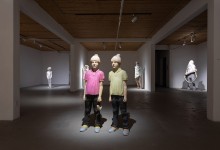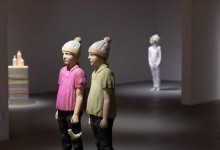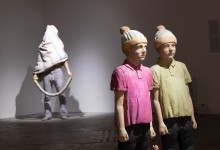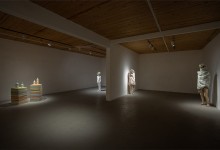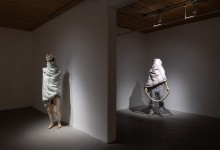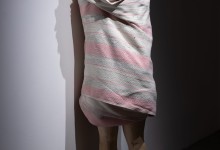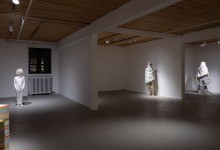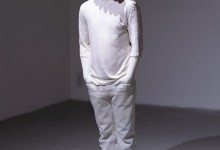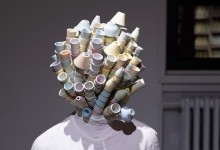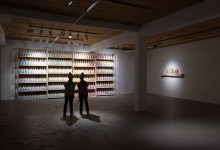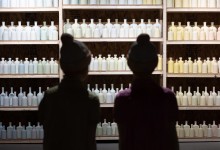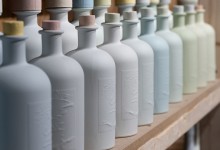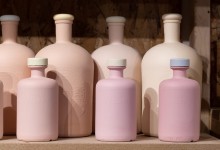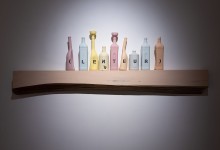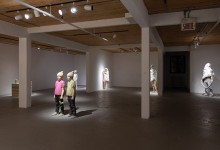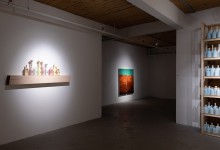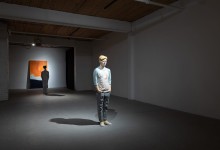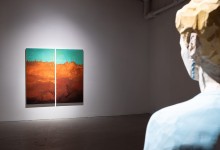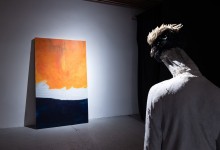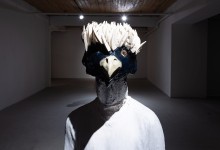Hélène et son mari (Hélène Chouinard et Jean-Robert Drouillard):
Les couleurs de la terre
Text by Liuba Gonzalez
Les couleurs de la terre is the first joint exhibition by artist duo Hélène et son mari, composed of ceramist Hélène Chouinard and multidisciplinary artist Jean-Robert Drouillard. Conceived as an expression of a decade of dialoguing creative practices, the exhibition explores the formation and transmission of artisanal knowledge by presenting finely-crafted objects in a contemporary light.
Hélène Chouinard’s works extend from her recent material research on clay colouring techniques. She methodically mixes two to three base pigments in various proportions, adding these directly to the clay to create a desired tone. Once molded and baked, this tone permeates the resulting object, not just its surface. Fascinated by the formal range of vessels from the mundane to the sophisticated, Chouinard reproduces everyday glass bottles by molding them in coloured porcelain. Each bottle bears a series of numbers that corresponds to the ratio of pigments used.
In their reinvention as pastel-coloured porcelain vessels, the bottles oscillate between functional handcrafted objects and items of aesthetic contemplation. The opacity of the porcelain conceals the contents of each bottle. The fine ceramic surface imitates the outline and texture of paper labels, but no printed text remains. The labels are blank: they signify that something is contained there, but not what it is. Smooth, even colour permeates each bottle and holds the eye at the level of the surface, asserting the handcrafted, sculptural quality of these objects. Armed with the knowledge that these are functional, exquisitely made vessels, the viewer is left to puzzle out what, if anything, they hold. Individually, these enigmatic bottles invite slow and close contemplation; as an ensemble they burst with colour, evoking a playful sense of abundance and wonder.
Facing a wall of Chouinard’s colourful vessels are Jean-Robert Drouillard iconic anthropomorphic sculptures: three wooden figures shrouded in woven catalogne from his series Des silhouettes emballées (Wrapped silhouettes).1 Scale imbues these figures with quasi-human presence. Here, as in Chouinard’s ceramics, the artists’ interest in craftsmanship is evident in the visibly hand-worked surface of the sculptures and inclusion of traditional woven textiles. The logic of the catalogne, which applies an artisan’s skill to renew old materials, contrasts Chouinard’s bottles, which recreate a familiar object in the novel material of pastel-coloured clay. Shrouded in their catalognes, Drouillard’s figures invoke questions of identity and the tangible objects that shape it.
The two bodies of work are locked in a dynamic theatrical interplay. Drouillard’s figures orient themselves towards Chouinard’s bottles. The dialogue is gestural, but also material: the figures are gently overgrown with elements of coloured porcelain. These intrusions –by-products of the bottle casting process– burst from the figures’ faces, obscuring and shaping their identities. This material symbiosis of figure and object hints at the gradual process of influence, where the ideas, values, and subtle idiosyncrasies of significant others become one’s own over time. In the case of Hélène et son mari, years of living and creating together have yielded vibrant contemporary visions for fine craft’s future.
1. A catalogne is a cloth made of woven scrap textiles that originated in 17th century Europe and was subsequently brought to French Canada, where it was used to make carpets and bed blankets, particularly in rural communities. Traditional catalognes are made of rags and old clothes, while commercial ones use new material.


